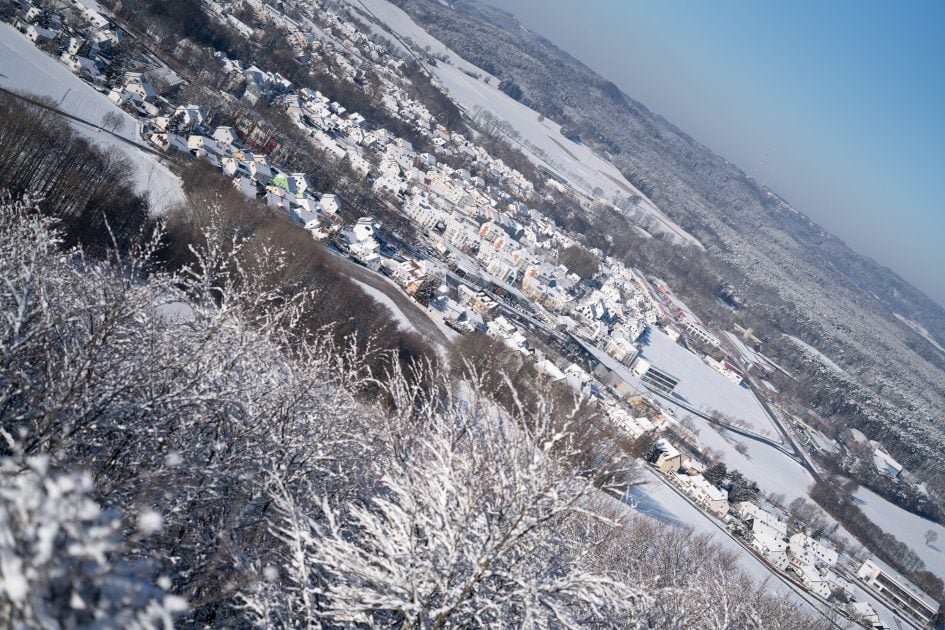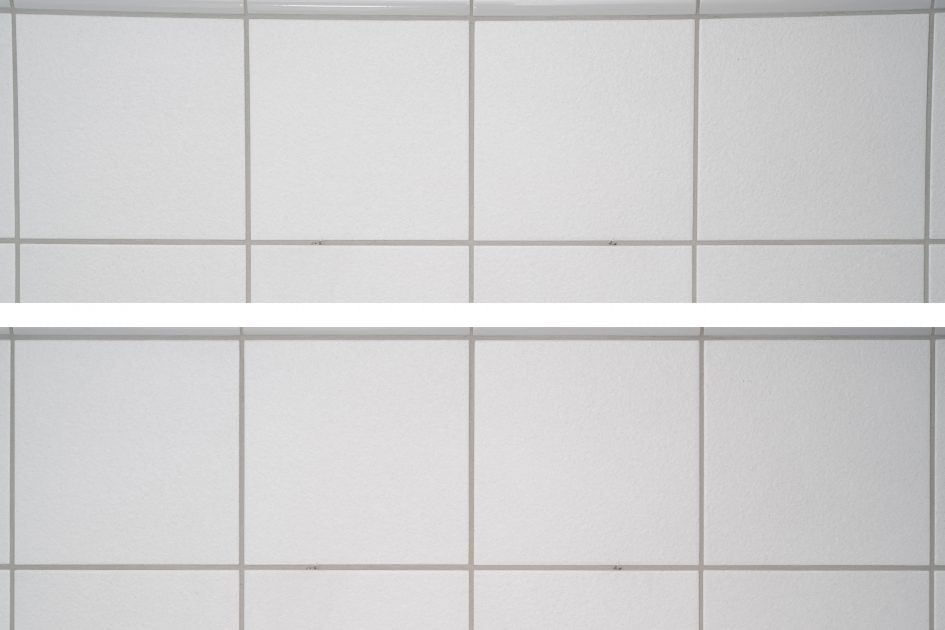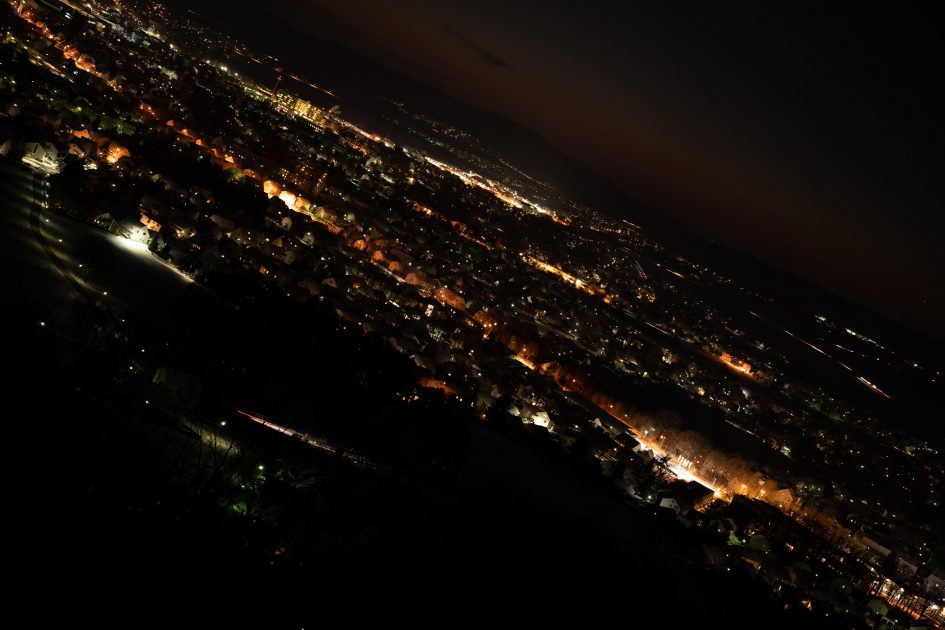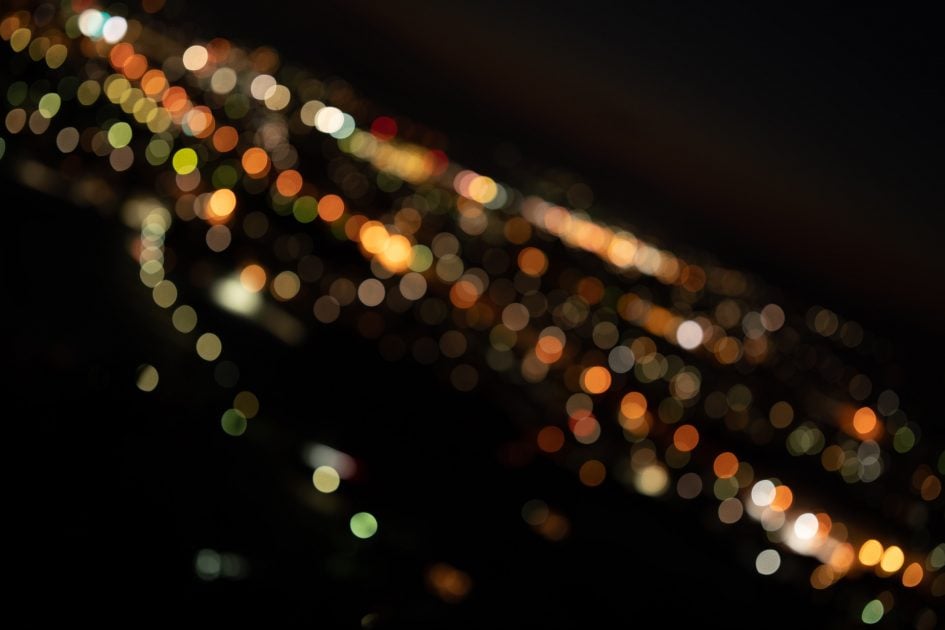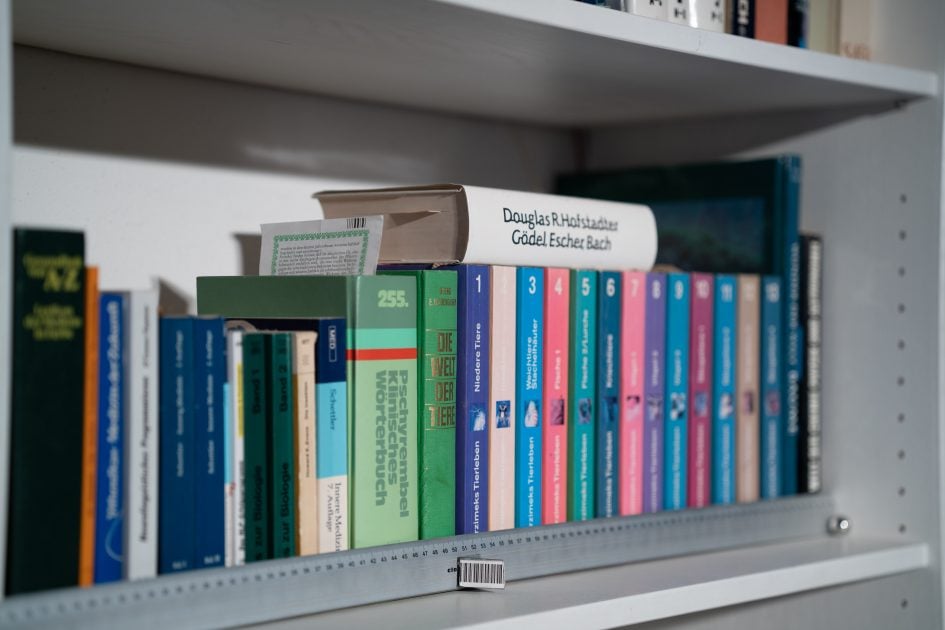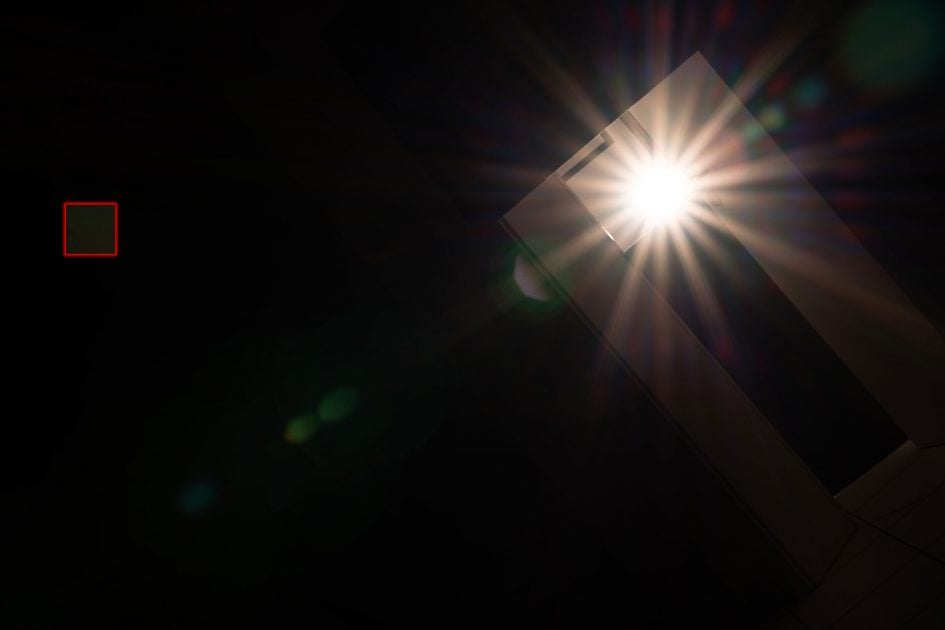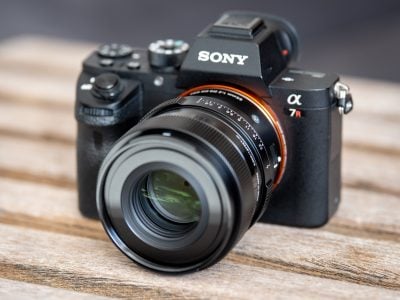Sigma 65mm f2 DG DN review
-
-
Written by Thomas
Quality
Testing: Longitudinal Chromatic Aberration and focus shift
Lenses with focal ratios of f2.8 or larger are often prone to longitudinal color aberrations (loCA, a.k.a. “axial color” or “bokeh CA”). These show up as magenta coloration in the foreground and greenish hues in the background and are not easily corrected in post-processing. The Sigma 65mm f2.0 DG DN shows relatively mild loCA. And there’s no discernible focus shift.
Sigma 65mm f2.0 DG DN longitudinal Chromatic Aberration (loCA)
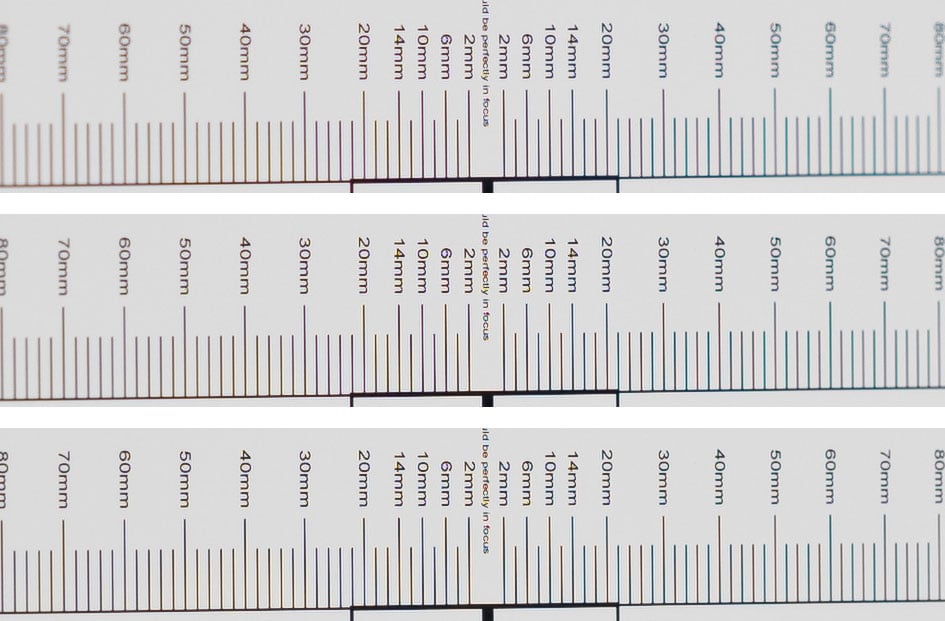
100% crops from top to bottom: f2.0, f2.8, f4.0; left = foreground, right = background
For comparison have a look at the Sigma 50mm f1.4 HSM Art and Sigma 85mm f1.4 DG DN Art, both at f1.4/f2.0/f2.8.
The following real life shot shows that the Sigma 65mm f2.0 DG DN produces no purple fringing around high-contrast edges in the focal plane and only a little green outlining around background subjects:

Above: Sigma 65mm f2.0 DG DN at f2.0, 100% crop
Sharpness and contrast
Let’s have a look at the theoretical performance of the Sigma 65mm f2.0 DG DN first and compare it to the Sigma 50mm f1.4 HSM Art and Sigma 85mm f1.4 DG DN Art:
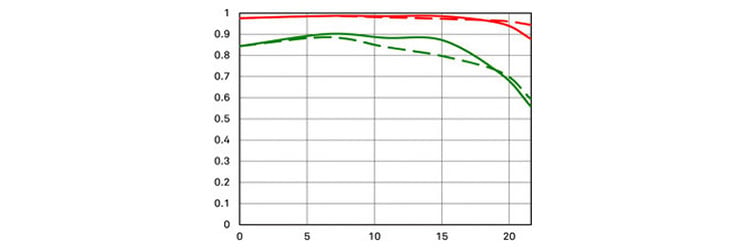
Above: Sigma 65mm f2.0 DG DN at f2.0
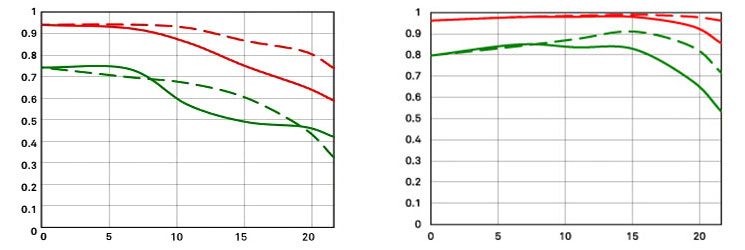
Above: Sigma 50mm f1.4 HSM Art (left), Sigma 85mm f1.4 DG DN Art at f1.4 (right)
These MTF charts show the computed lens-performance of lenses wide open without influence of diffraction at 10 line-pairs/mm (red) and 30 lp/mm (green). Higher values are better (more contrast) and the closer the line-pairs are together the less astigmatism (= resolution depends on the orientation of the test-pattern) the lens has. The x-axis displays the distance from the optical axis (=center of the sensor) in mm. I’ll show you the real-life performance at 4 mm (center), 13 mm (APS-C-corner), and 20 mm (FF-corner) on a on a 42MP Sony A7R II camera.
From the charts the new optical construction of the Sigma 65mm f2.0 DG DN looks promising at f2.0, certainly better than from the Sigma 50mm f1.4 HSM Art at f1.4. The Sigma 85mm f1.4 DG DN Art shows comparable contrast/sharpness – but that is f1.4. At f2.0 the 85mm lens should be sharper than the 65mm.
Let’s see how this theoretical performance translates into real life results in the sharpness test based on Siemens-stars. Processing was done in Lightroom 10.1/CRAW 13.1 from RAW to Adobe Color profile with the built-in lens profile for Vignette Control and CA compensation applied. Noise-reduction is set to 0, sharpening to 50/0.5/36/10, with no extra tone, color, or saturation adjustment. White-balance was adjusted to a neutral white and I did some exposure compensation to make the brightness of all crops match. So you will not see light fall-off in the corners.
The following 100% crops show the Sigma 65mm f2.0 DG DN from f2.0 down to f11 compared to the Sigma 50mm f1.4 HSM Art and Sigma 85mm f1.4 DG DN Art at f2.0.
Sigma 65mm f2.0 DG DN compared; 100% crop from center, APS-C-corner, FF-corner

Above: Sigma 65mm f2.0 DG DN at f2.0

Above: Sigma 50mm f1.4 HSM Art at f2.0

Above: Sigma 85mm f1.4 DG DN Art at f2.0

Above: Sigma 65mm f2.0 DG DN at f2.8

Above: Sigma 65mm f2.0 DG DN at f4.0

Above: Sigma 65mm f2.0 DG DN at f5.6; also available at f8.0, f11
Performance of Sigma’s 65mm f2.0 DG DN is already very good at f2.0 – if you can compensate for field curvature. The lens is clearly sharper than the Sigma 50mm f1.4 HSM Art across the sensor. But the Sigma 85mm f1.4 DG DN Art is still a bit sharper outside the center.
Performance at long distances
The Siemens-star test-targets are shot at a distance of 45x focal length (i.e. at around 3m). But performance of lenses also depends on the shooting distance. Therefore I present another series of test-shots of a city around 1 km away. Processing was done in Lightroom 10.1/CRAW 13.1 from RAW to Adobe Color profile with the built-in lens profile compensating vignetting and CA. Noise-reduction is set to 0, sharpening to 50/0.5/36/10, with no extra tone, color, or saturation adjustment. I used manual focus at the largest aperture and did not change focus for other apertures. All shots were made at ISO 100 and image stabilization switched off.
The following image shows the complete scene wide open to give you an impression of the angle of view. Following the main image are 100% crops from the center, APS-C-corner, and FF-corner from the new Sigma 65mm f2.0 DG DN from f2.0 down to f11 compared to the Sigma 50mm f1.4 HSM Art and Sigma 85mm f1.4 DG DN Art at f2.0 shot at different days – but with comparably clear atmosphere. As usual I have selected the diagonal that provided the better corner results as almost any lens is a bit decentered.
You can access the large originals but please respect our copyright and only use those images for personal use.
Above: Sigma 65mm f2.0 DG DN at f2.0
Above: Sigma 65mm f2.0 DG DN at f2.0; 100% crops, click image for 4k version, here for large original
Above: Sigma 50mm f1.4 Art at f2.0; 100% crops, click image for 4k version, here for large original
Above: Sigma 85mm f1.4 DG DN Art at f2.0; 100% crops, click image for 4k version, here for large original

Above: Sigma 65mm f2.0 DG DN at f2.8

Above: Sigma 65mm f2.0 DG DN at f4.0

Above: Sigma 65mm f2.0 DG DN at f5.6; also available at f8.0, f11
With no correction for field curvature the FF-corner of the Sigma 65mm f2.0 DG DN now looks definitely softer than in the previous test. But the lens is still sharper than the Sigma 50mm f1.4 Art outside the center. And the Sigma 85mm f1.4 DG DN Art clearly is the sharpest of the three lenses. To reduce the effect of field curvature on flat or distant subjects stop the Sigma 65mm f2.0 DG DN down to f4.0.
Vignetting and distortions
To make it easier to see light fall-off in the corners of a full-frame sensor I’ve arranged a series of shots with the Sigma 65mm f2.0 DG DN at different apertures. All images were developed to the same brightness in the center.
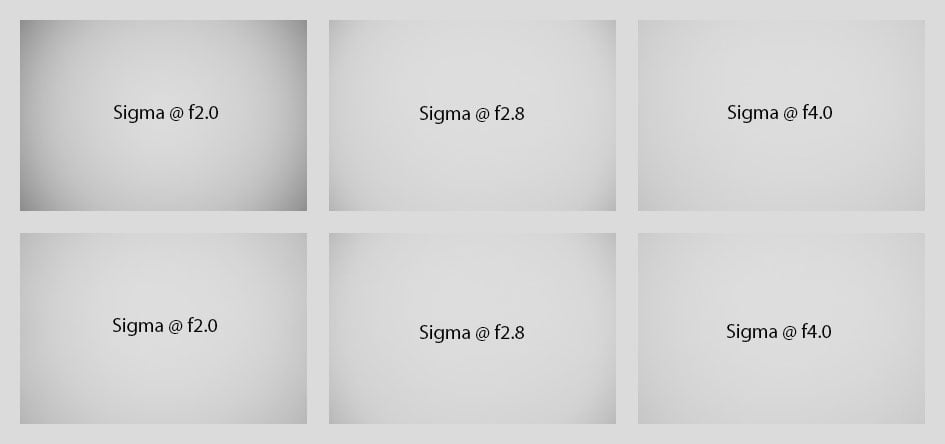
Above: Sigma 65mm f2.0 DG DN with shading compensation OFF (top), and shading compensation AUTO (bottom) at f2.0, f2.8, f4.0
The sample images above show that with the lens profile applied vignetting of the Sigma 65mm f2.0 DG DN is almost negligible. Automatic shading compensation lifts the extreme corners about 0.8 EV at f2.0. Adobe’s RAW converter automatically applies shading compensation as it was set in camera – but you cannot alter the setting in postprocessing.
Distortions are of a pretty strong pin-cushion type. The setting for distortion compensation in camera is currently ignored by Adobe’s RAW converter and treated as OFF and there is also no lens profile for the Sigma 65mm f2.0 DG DN in Lightroom 10.1 / CRAW 13.1. This hopefully gets remedied in a later version. To get rid of the distortions you have to manually dial in a compensation of -7 in Lightroom (see below). When shooting JPGs the camera at least does a pretty good job with Sigma’s lens profile to correct for distortions.
Distortions: Sigma 65mm f2.0 DG DN, as is (top) / with a compensation of -7 (bottom)
Rendering of point-light sources at night-shots
Night-shots pose a different challenge for lenses as the contrast is even higher than under bright sun and point-light sources can reveal some weaknesses such as coma, haloing and colour-aberrations that do not show up as prominently in other test-shots. The 100% crops below the main image show the effect of coma in the FF-corner of the new Sigma 65mm f2.0 DG DN at different apertures:
Above: Sigma 65mm f2.0 DG DN at f2.0; click image for 4k version, here for large original

Above: Sigma 65mm f2.0 DG DN; 100% crops from the FF-corner at f2.0 (left), f2.8 (middle), f4.0 (right)
The Sigma 65mm f2.0 DG DN produces very little coma even wide open.
Bokeh quality
This test is for the rendering of point-light sources in an out-of-focus background. The circle of confusion that is produced by this test is pretty indicative of Bokeh performance (in the background) and light fall-off. Ideally the out-of-focus image of the point-light is evenly lit and perfectly circular, with no “onion-rings”, and without coloration. Large aperture lenses normally produce an effect known as “cat’s eye” the further away from the optical axis the point-light is projected. This is due to optical vignetting in the lens barrel when light enters the lens from an angle.
The crops below the main image are from the center, APS-C-corner, and FF-corner at different apertures resized to make them comparable across all my reviews.
Above: Sigma 65mm f2.0 DG DN at f2.0
Above: Sigma 65mm f2.0 DG DN at f2.0; click image for 4k version

Above: Sigma 65mm f2.0 DG DN at f2.8

Above: Sigma 65mm f2.0 DG DN at f4.0
Wide open the entrance pupil of the Sigma 65mm f2.0 DG DN at 33mm is only slightly smaller than from the Sigma 50mm f1.4 HSM Art at 36mm but much smaller than from the Sigma 85mm f1.4 DG DN Art at 61mm. So at identical magnifications the 65mm f2.0 and the 50mm f1.4 lens should produce Bokeh balls of similar size in the background while the 85mm f1.4 lens renders them at almost double the diameter.
Compression of the circle towards the corners looks relatively mild at f2.0 and is gone at the FF-corner at f4.0. But at that aperture the circle of confusion is no longer perfectly round. The inside of the Bokeh balls is only slightly textured with no onion-rings but there is some outlining and a bit of green coloration from longitudinal CA.
Now let’s see how this analysis of out-of-focus point-light sources translates into Bokeh-performance shooting a book-shelf. Crops are from the foreground, middle-ground, and background resized to make them comparable across all my reviews.
Above: Sigma 65mm f2.0 DG DN at f2.0
Above: Sigma 65mm f2.0 DG DN at f2.0; click image for 4k version, here for large original
Above: Sigma 50mm f1.4 HSM Art at f1.4; click image for 4k version, here for large original
Above: Sigma 85mm f1.4 DG DN Art at f1.4; click image for 4k version, here for large original
At f2.0 Bokeh of the Sigma 65mm f2.0 DG DN in the background is just a tad more nervous than from the Sigma 50mm f1.4 HSM Art at f1.4. But in the middle-ground the 50mm lens renders the softer transition than the 65mm lens. The best background blur is produced by the Sigma 85mm f1.4 DG DN Art at f1.4.
Looking at another crop (now at 100%) from the same images showing the ruler reveals a slight tendency for double contours of the Sigma 65mm f2.0 DG DN – but nothing I’d worry about. The 50mm f1.4 HSM Art seems the softest here with the 85mm f1.4 DG DN Art somewhat in-between.
Above: Sigma 65mm f2.0 DG DN at f2.0; 100% crop, click image for 4k version, here for large original
Above: Sigma 50mm f1.4 HSM Art at f1.4; 100% crop, click image for 4k version, here for large original
Above: Sigma 85mm f1.4 DG DN Art at f1.4; 100% crop, click image for 4k version, here for large original
All-in-all the Sigma 65mm f2.0 DG DN produces a Bokeh at f2.0 that is pretty close to the Sigma 50mm f1.4 HSM Art at f1.4. Shoot both lenses at f2.0 and there’s not much to distinguish between them. To a lesser degree this is also true when compared to the 85mm f1.4 shot at f2.0. But make no mistake: shooting the Sigma 85mm f1.4 DG DN Art at f1.4 produces the best Bokeh of the three lenses.
Flare, ghosting, and sun-stars
Catching a strong light-source shining directly into the lens is always a risky business: it could produce strange colorful ghost-images or reduce contrast considerably through flare and glare. The appearance of flare and ghosting depends on factors like the aperture and the angle of the light hitting the lens. So to judge the proclivity of the new Sigma 65mm f2.0 DG DN for these artifacts I went through a series of well calculated shots against a strong light source to provoke glare and ghosting. The lens hood was mounted in all shots. Following is one of the more extreme example results. The little bright square inset in the upper left shows the respective area with an exposure compensation of +3 EV to make it easier to see which levels of black the lens renders at that point:
Above: Flare and ghosting. Strong light hitting the Sigma 65mm f2.0 DG DN at f11; click image for 4k version or here for +3 EV exposure compensation
The Sigma 65mm f2.0 DG DN produces some ghosting artifacts and overall contrast is a bit reduced through veiling glare. The lens starts to produce visible sunstars from f5.6 or smaller apertures:

Above: Sunstars from the Sigma 65mm f2.0 DG DN at f5.6, 100% crop
Next check out my sample images!
Check prices on the Sigma 65mm f2 DG DN at B&H, Adorama, WEX or Calumet.de. Alternatively get yourself a copy of my In Camera book or treat me to a coffee! Thanks!